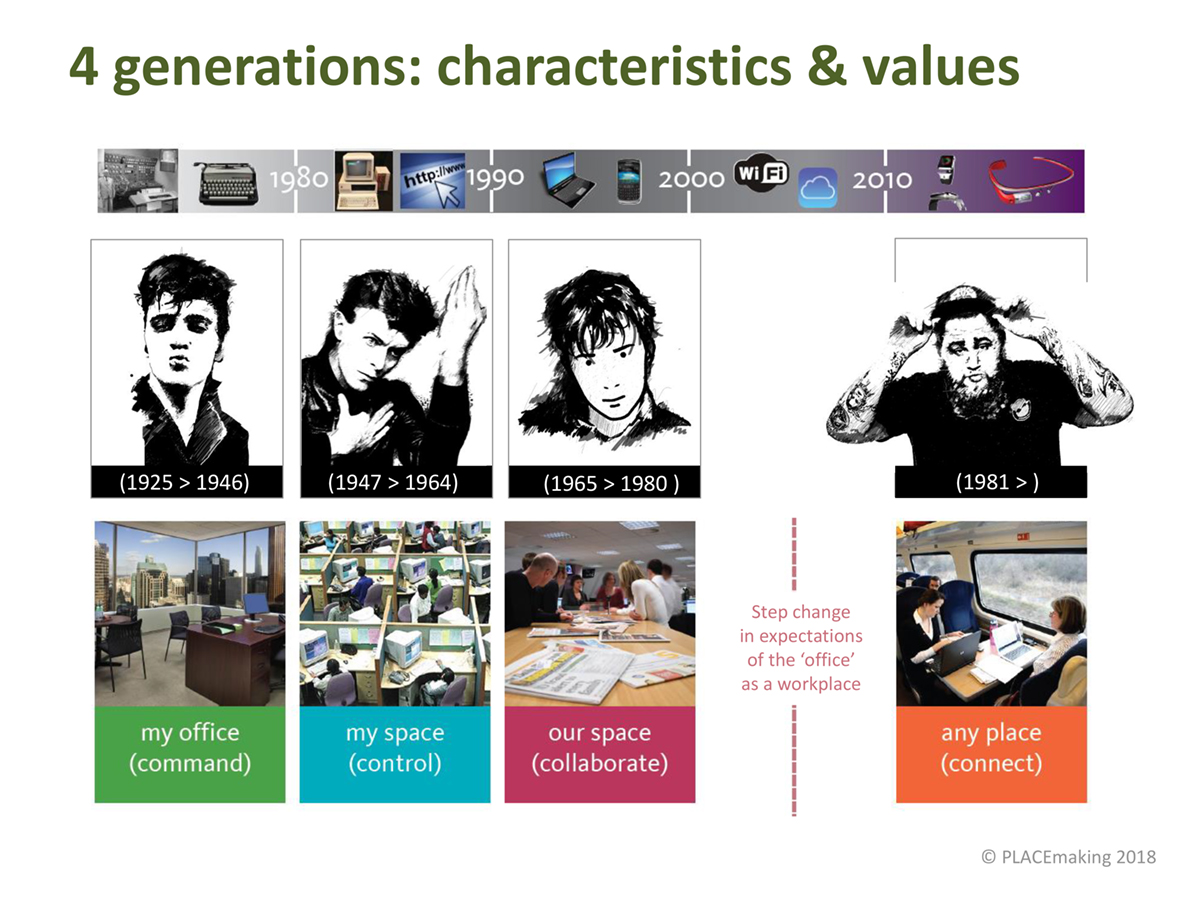Alison White, co-founder of PLACEmaking, shares her thoughts on the extent to which modern working practices are slowly eroding the outdated office culture of previous generations
With small, medium and large enterprises now more than ever aware of the cost of providing, servicing and maintaining often grossly underutilised office space, the time is right for a total rethink the role and purpose of the ‘office’. Whilst utilisation of the traditional office space was always significantly lower than people thought, modern work patterns are gradually heralding the slow ‘death’ of the traditional office.
Those changing work patterns are often referred to as smart working, which is being adopted across the private and public sectors – and at pace. Whilst a drive to reduce the cost of an office estate is not the sole motive for embracing smart working, the realised benefits deliver both tangible financial savings and other significant non-tangible advantages.
What is smart working?
Smart working means providing people with the tools – the culture and leadership, workspace and technology – that enable people to choose when, where and how they do their jobs.
Technology has led to the automation of previously manual administrative tasks and remote access to internet-based services enables a greater number of jobs to be carried out remotely from the office. As a result, more of us have a greater choice of where and when we work. This has reduced our dependency on the traditional office environment and as fewer of us are working in the same space 9-5 and five days a week, common office practices associated with an administrative structure, control and hierarchy begin to seem out dated and irrelevant.
The trouble is, if the traditional office is not what we want anymore, then how do we agree what to put in its place? The ‘office’ means different things to different people: whilst we might not spend a great deal of time in it the notion of losing something that is so familiar for something comparatively unknown is no doubt exciting for some, but unsettling for many.
How do we ensure the voices of all four generations that make up the modern workforce are heard and how do we engage with them to ensure that the transition from a traditional way of working to a new solution is successful, business practices are updated, productivity is increased, and the health and well-being of people improved? If we are committed to modernising the workplace (and we must be), then we must also be fully prepared to help people through this transformational change.
Changing working practices
Many embedded working practices evolved in the past when the pace of change was slower and therefore rarely challenged. When mass processing of paper-based information was workforce dependent, the organisational ‘machine’ only functioned when all employees arrived at, operated within and finished at set times. The early computers mechanised that process and sped up the output results. We maintained the same supervised, administrative work styles: pushing aside paper-based in and out-trays and slowly replacing them with computer terminals (initially), microcomputers (1975-78) and then PCs (1980-86). We might have changed the tools, but we maintained the same working practices, turning the computers ‘on’ in the morning and ‘off’ at the end of the typical human working day.
Of course, the functionality of today’s computers bears no resemblance to those early versions and the processing power each of us carries around in our laptop or tablet was inconceivable back in the day of central IT suites, hard-wired to heat-generating desktop computers. Light years of technology transformation has happened within the working lifetime of many of us and yet, too many working practices and attitudes have been slow to adapt, and many offices still look and operate in the same way as they did prior to the introduction of business computing. It is almost that we have maintained the working practices of a pirate while we carry around the computing power of an astronaut.
With the pace of computing and associated business advancements, are we ensuring that our human resources are happily functioning with the changes they have already experienced and all eagerly looking forward to the impact of the next wave of change? If business leaders assume everyone in their business that they rely on to function productively responds to change in the same way, then they are as out of date as their offices. Simply shoehorning a pirate into a space suit does not make him or her an astronaut.
Four generations in the workplace
It is too simplistic to assume everyone perceives smart working and the associated flexibility of how, when and where we work as entirely desirable. The generic profiles of veterans, baby boomers and generations X & Y are familiar terms often used to describe the characteristics of the four generations that make up the modern workforce (Jeffery G. Harber, 2011). The opinions and expectations of these four generational groups vary: unconsciously influenced by the social, economic and political context of when they were born, educated and first entered the workplace. Their value sets are different and what ‘work’ means to them, as well as what they actually expect from ‘going to work’ varies enormously. Their opinions about the need or purpose of the ‘office’; how an enterprise operates and what sorts of behaviours are acceptable is influenced by many things, including their generational profile. Appreciating what influences their views and reactions provide us with a framework for shaping how we communicate planned changes, how we understand their often-unconscious reaction to new challenges and how we help them prepare for and exploit the opportunities available from smart working.
Whilst the terms and definitions of veterans, baby boomers and generations X & Y are useful for academic research and data comparison, in our experience few people appreciate being identified by these age-related labels. Instead, we use other approaches to enable individuals to identify for themselves their own cohort group using, for example, music legends and icons. We can all relate to the key superstars that dominated our generational group, even if we were not specific fans. We select artists that are identified as influencing youth culture of a period of time yet have become or are becoming accepted and respected across generational boundaries. Being associated with such icons could, of course, defines each personal generational group, but being affiliated with a celebrated icon is a more positive badge of pride than simply an age-related label.
Cross-generational discussion and an increased awareness of each other’s career expectations – as well as changes experienced to the workplace environment, technologies and ways of working – breaks down barriers and forges better mutual awareness and empathies. In contrast to the traditional method of ‘sheep dipping’ – through classroom-based and one-size-fits-all training sessions – we help people identify their own engagement profile and their communication style preferences, ensuring everyone can self-select their own profiled ‘roadmap’ to access and engage with relevant information and sign-post them to communications activities that best suit their personal profile.
The benefit of this approach is that it is scalable to match to the size of any enterprise, the media used is adaptable (mix of electronic and/or face to face) and users have greater choice on when, how and how often they engage with the change process. With the entry point to the engagement tool being electronic, we can track and report levels of engagement and monitor selection preferences which in turn, informs the design, specification and targeted investment of our engagement and communications strategies. This increases the consistency and quality of information provided, boosts accuracy in targeted engagement and reduces the wastage of time, therefore delivering more value for money.
The future
And what about generation Z, the next generation yet to enter the workforce? How are we preparing for their arrival into the world of work? What will their expectations be and what will have influenced their opinions about and requirements of the workplace? These are the children of the current generations X and Y who themselves should have been profiting from the flexible working arrangements associated with smart working. Is generation Z witnessing how their parents have been supported to embrace the advantages of smart working, have more choice on when and where to work and are enabled to balance work with other responsibilities and interests?
Or are their parents the unlucky ones who have had change forced on them and share horror stories of how they lost their own desk and were forced to work from home? Does generation Z assume they will be forced to work 9-5 in large office blocks in city centres, negotiating streets choked with the same pattern of rush hour traffic every day? Will they be disappointed on their first day of work to be directed to a desk, with poorer technology on it than they have at home, in a cluttered and uninspiring office and will they be supervised by someone with poor management skills influenced by a limited awareness of how work is changing? How quickly that generation will realise that the world of work hasn’t quite matched their expectations.
On the horizon is more change and recognising a landscape of constant change is the destiny of any enterprise if it is to be sustainable. Business leaders need to balance the opportunities and risks that on-going change brings and accept that imposing change, as it was done in the past, is no longer viable. They need a workforce that accepts and expects change if the business is not be exploited by it. That baton of responsibility for understanding the need for change needs to be handed from the employer to the employee.
And so where does this leave the topic of “the slow death of the office”. The ‘office’ can no longer be regarded as an expensive necessity, subject therefore to property driven rationalisation focused initiatives. Attempts to convince people that the technology advances they are witnessing and experiencing is not being matched by new working practices and alternative types of ‘office’ solutions are fundamentally flawed. Persuading people that the same desk-based solutions are still relevant, but they just need to have access to less of it, misses the point entirely and younger generations are explicitly rejecting such workplaces along with the outdated management practices that go with it.
People can and will vote with their feet and with laptops under their arms, a mobile phone and remote access to internet stored information, they are finding alternative places to work and spending minimal time in their employer old offices. Look around any office on a Friday and it’s practically empty and with average utilisation consistently measuring at under 45% in core hours, the real cost of out of date offices is more than the cost of real estate.
Forget the old image of the office made up of rows of desks, cellular offices and a few meeting rooms and ignore so-called property and facilities management experts whose mantra that minimising property costs, at all costs is a business key objective. A major cost of low office occupation is the loss of face to face interaction, tacit knowledge sharing, networking and team bonding. Addressing such issues need a change of approach, rather than reinstating old management practices of presenteeism.
The ‘office’ needs to be a place where people want to go – not somewhere they are forced to tolerate. We might not want or need the traditional ‘office’ anymore, but we do often want to go to a place, or places where we get together with others for mental stimulation, energy enhancing discussion and debates, emotional support, exposure to alternative thoughts and experience simple personal reassurance. As such, we need an enriched range of work setting to select from and make use of that directly to help us achieve our objectives and complete our tasks. We need places that reinforce our personal role as part of a collective enterprise, with a greater emphasis on informality and shared contribution and less on hierarchy and stiff formality. We might not want cramped and cluttered offices, but we also don’t want to be isolated, sit in our pyjamas at home or beg tablespace in a local coffee shop all the time either. Employers who invest in new thinking and new work environment will find attracting and retaining the talent they need to sustain their businesses all the easier.
Our expertise and skills enable PLACEmaking to deliver end-to-end professional services, developed to support our clients achieve their change objectives, including:
- Workplace change management;
- Communications & engagement solutions;
- Interior architecture & design;
- Strategic asset management;
- Digital and technology advisory and;
- Programme management.
Now is the time to update and upgrade expectations about the workplace, how it operates and how we productively function in it. If more than 30% of your office space has desks in it or meeting rooms are the only alternative spaces available to get away from the desk, then it’s time to review how your workplace is holding you back from achieving your business vision, objectives and expectations.
2017 National winner of the Cabinet Office’s TW3 (The Way We Work) award
Please note: this is a commercial profile
Alison White
Co-founder
PLACEmaking













